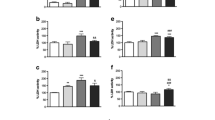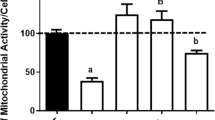Abstract
Cell rescue is a primary need during acute and chronic insults to the central nervous system. Functional preservation during the early stages of toxicity in a given degenerative event may represent a significant amelioration of detrimental processes linked to neuronal cell loss. Excitotoxicity and depleted cellular energy are toxic events leading to cell death in several neurodegenerative disorders. In this work, the effects of the well-known antioxidant and energy precursor, l-carnitine (l-CAR), were tested as a post-treatment in two neurotoxic models under in vitro and in vivo conditions. The experimental models tested included: (1) a typical excitotoxic and pro-oxidant inducer, quinolinic acid (QUIN); and (2) a mitochondrial energy inhibitor, 3-nitropropionic acid (3-NP). For in vitro studies, increasing concentrations of l-CAR (10–1,000 μM) were added to the isolated brain synaptosomes at different times (1, 3 and 6 h) after the incubation with toxins (100 μM QUIN and 1 mM 3-NP), and 30 min later, lipid peroxidation (LP) and mitochondrial dysfunction (MD) were evaluated. For in vivo purposes, l-CAR (100 mg/kg, i.p.) was given to rats either as a single administration 120 min after the intrastriatal infusion of QUIN (240 nmol/μl) or 3-NP (500 nmol/μl), or for 7 consecutive days (starting 120 min post-lesion). LP and MD were evaluated 4 h and 7 days post-lesions in isolated striatal synaptosomes. Our results show that, despite some variations depending on the toxic model tested, the time of exposure, or the biomarker evaluated, nerve ending protection can be mostly achieved by l-CAR within the first hours after the toxic insults started, suggesting that targeting the ongoing oxidative damage and/or energy depletion during the first stages of neurotoxic events is essential to rescue nerve endings.






Similar content being viewed by others
References
Alexi T, Hughes PE, Faul RL, Williams CE (1998) 3-Nitropropionic acid’s lethal triplet: cooperative pathways of neurodegeneration. Neuroreport 9:R57–R64
Alves E, Binienda Z, Carvalho F, Alves CJ, Fernandes E, de Lourdes Bastos M, Tavares MA, Summavielle T (2009) Acetyl l-carnitine provides effective in vivo neuroprotection over 3, 4-methylenedioximethamphetamine-induced mitochondrial neurotoxicity in the adolescent rat brain. Neuroscience 158:514–523
Beal MF (2004) Mitochondrial dysfunction and oxidative damage in Alzheimer’s and Parkinson’s diseases and coenzyme Q10 as a potential treatment. J Bioenerg Biomembr 36:381–386
Beal MF, Kowall NW, Ellison DW, Mazurek MF, Swartz KJ, Martin JB (1986) Replication of the neurochemical characteristics of Huntington’s disease by quinolinic acid. Nature 321:168–171
Behan WM, McDonald M, Darlington LG, Stone TW (1999) Oxidative stress as a mechanism for quinolinic acid-induced hippocampal damage: protection by melatonin and deprenyl. Br J Pharmacol 128:1754–1760
Binienda ZK, Ali SF (2001) Neuroprotective role of l-carnitine in the 3-nitropropionic acid induced neurotoxicity. Toxicol Lett 125:67–73
Binienda Z, Virmani A (2003) The mitochondriotropic effects of l-carnitine and its esters in the central nervous system. Curr Med Chem Cent Nerv Syst Agents 3:275–282
Binienda Z, Virmani A, Przybyla-Zawislak B, Schmued L (2004) Neuroprotective effect of l-carnitine in the 3-nitropropionic acid (3-NPA)-evoked neurotoxicity in rats. Neurosci Lett 367:264–267
Brouillet E, Jenkins BG, Hyman BT, Ferrante RJ, Kowall NW, Srivastava R, Roy DS, Rosen BR, Beal MF (1993) Age-dependent vulnerability of the striatum to the mitochondrial toxin 3-nitropropionic acid. J Neurochem 60:356–359
Brouillet E, Condé F, Beal MF, Hantraye P (1999) Replicating Huntington’s disease phenotype in experimental animals. Prog Neurobiol 59:427–468
Choi DW (1990) Cerebral hypoxia: some new approaches and unanswered questions. J Neurosci 10:2493–2501
Coyle JT, Puttfarcken P (1993) Oxidative stress, glutamate, and neurodegenerative disorders. Science 262:689–695
Gülçin I (2006) Antioxidant and antiradical activities of l-carnitine. Life Sci 78:803–811
Hagen TM, Moreau R, Suh JH, Visioli F (2002) Mitochondrial decay in the aging rat heart: evidence for improvement by dietary supplementation with acetyl-l-carnitine and/or lipoic acid. Ann NY Acad Sci 959:491–507
Herrera-Mundo MN, Silva-Adaya D, Maldonado PD, Galván-Arzate S, Andrés-Martínez L, Pérez-De La Cruz V, Pedraza-Chaverrí J, Santamaría A (2006) S-Allylcysteine prevents the rat from 3-nitropropionic acid-induced hyperactivity, early markers of oxidative stress and mitochondrial dysfunction. Neurosci Res 56:39–44
Lin MT, Beal MF (2006) Mitochondrial dysfunction and oxidative stress in neurodegenerative diseases. Nature 443:787–795
Lowry OH, Rosebrough NJ, Farr AL, Randall RJ (1951) Protein measurement with the Folin phenol reagent. J Biol Chem 193:265–275
Ludolph AC, He F, Spencer PS, Hammerstad J, Sabri M (1991) 3-Nitropropionic acid-exogenous animal neurotoxin and possible human striatal toxin. Can J Neurol Sci 18:492–498
Mansour HH (2006) Protective role of carnitine ester against radiation-induced oxidative stress in rats. Pharmacol Res 54:165–171
Martin RL, Lloyd HG, Cowan AI (1994) The early events of oxygen and glucose deprivation: setting the scene for neuronal death? Trends Neurosci 17:251–257
Miller OO (1996) Minerals. In: Fennema OR (ed) Food chemistry, 38 edn. Marcel Dekker, New York, pp 618–649
Muthuswamy AD, Vedagiri K, Ganesan M, Chinnakannu P (2006) Oxidative stress-mediated macromolecular damage and dwindle in antioxidant status in aged rat brain regions: role of l-carnitine and DL-α-lipoic acid. Clin Chim Acta 368:84–92
Nalecz KA, Nalecz MJ (1996) Carnitine: a known compound, a novel function in neural cells. Acta Neurobiol Exp (Wars) 56:597–609
Nicholls DG, Johnson-Cadwell L, Vesce S, Jekabsons M, Yadava N (2007) Bioenergetics of mitochondria in cultured neurons and their role in glutamate excitotoxicity. J Neurosci Res 85:3206–3212
Pang Z, Geddes JW (1997) Mechanisms of cell death induced by the mitochondrial toxin 3-nitropropionic acid: acute excitotoxic necrosis and delayed apoptosis. J Neurosci 17:3064–3073
Paradies G, Petrosillo G, Gadaleta MN, Ruggiero FM (1999) The effect of aging and acetyl-l-carnitine on the piruvate transport and oxidation in rat heart mitochondria. FEBS Lett 454:207–209
Paxinos G, Watson C (1998) The rat brain in stereotaxic coordinates. Academic Press, San Diego
Pérez-De La Cruz V, González-Cortés C, Galván-Arzate S, Medina-Campos ON, Pérez-Severiano F, Ali SF, Pedraza-Chaverrí J, Santamaría A (2005) Excitotoxic brain damage involves early peroxynitrite formation in a model of Huntington’s disease in rats: protective role of iron porphyrinate 5, 10, 15, 20-tetrakis (4-sulfonatophenyl)porphyrinate iron (III). Neuroscience 135:463–474
Pérez-De La Cruz V, Konigsberg M, Pedraza-Chaverrí J, Herrera-Mundo N, Díaz-Muñoz M, Morán J, Fortoul-van der Goes T, Rondán-Zárate A, Maldonado PD, Ali SF, Santamaría A (2008) Cytoplasmic calcium mediates oxidative damage in an excitotoxic/energetic deficit synergic model in rats. Eur J NeuroSci 27:1075–1085
Petrosillo G, Fattoretti P, Matera M, Ruggiero FM, Bertoni-Freddari C, Paradies G (2008) Melatonin prevents age-related mitochondrial dysfunction in rat brain via cardiolipin protection. Rejuvenation Res 11:935–943
Rani PJ, Panneerselvam C (2001) Protective efficacy of L-carnitine on acetylcholinesterase activity in aged rat brain. J Gerontol A Biol Sci Med Sci 56:B140–B141
Roe CR, Hoppel CL, Stacey TE, Chalmers RA, Tracey BM, Millington DS (1983) Metabolic response to carnitine in methylmalonic aciduria: an effective strategy for elimination of propionyl groups. Arch Dis Child 58:916–920
Roe CR, Millington DS, Maltby DA, Bohan TP, Hoppel CL (1984) l-Carnitine enhances excretion of propionyl coenzyme A as propionylcarnitine in propionic acidemia. J Clin Invest 73:1785–1788
Rossato JI, Ketzer LA, Centurião FB, Silva SJ, Lüdtke DS, Zeni G, Braga AL, Rubin MA, Rocha JB (2002) Antioxidant properties of new chalcogenides against lipid peroxidation in rat brain. Neurochem Res 27:297–303
Rothman SM, Olney JW (1986) Glutamate and the pathophysiology of hypoxic-ischemic brain damage. Ann Neurol 19:105–111
Santamaría A, Jiménez ME (2005) Oxidative/nitrosative stress, a common factor in different neurotoxic paradigms: an overview. Curr Topics Neurochem 4:1–20
Santamaría A, Ríos C (1993) MK-801, an N-methyl-d-aspartate receptor antagonist, blocks quinolinic acid-induced lipid peroxidation in rat corpus striatum. Neurosci Lett 159:51–54
Sas K, Robotka H, Toldi J, Vécsei L (2007) Mitochondria, metabolic disturbances, oxidative stress and the kynurenine system, with focus on neurodegenerative disorders. J Neurol Sci 257:221–239
Schwarcz R, Whetsell WO Jr, Mangano RM (1983) Quinolinic acid: an endogenous metabolite that produces axon-sparing lesions in rat brain. Science 219:316–318
Schwarcz R, Foster AC, French ED, Whetsell WO Jr, Köhler C (1984) Excitotoxic models for neurodegenerative disorders. Life Sci 35:19–32
Shug AL, Schmidt MJ, Golden GT, Fariello RT (1982) The distribution and role of carnitine in the mammalian brain. Life Sci 31:2839–2874
Silva-Adaya D, Pérez-De La Cruz V, Herrera-Mundo MN, Mendoza-Macedo K, Villeda-Hernández J, Binienda Z, Ali SF, Santamaría A (2008) Excitotoxic damage, disrupted energy metabolism, and oxidative stress in the rat brain: antioxidant and neuroprotective effects of l-carnitine. J Neurochem 105:677–689
Stone TW (1993) Neuropharmacology of quinolinic and kynurenic acids. Pharmacol Rev 45:309–379
Túnez I, Montilla P, Del Carmen-Muñoz M, Feijóo M, Salcedo M (2004) Protective effect of melatonin on 3-nitropropionic acid-induced oxidative stress in synaptosomes in an animal model of Huntington’s disease. J Pineal Res 37:252–256
Wüllner U, Young AB, Penney JB, Beal MF (1994) 3-Nitropropionic acid toxicity in the striatum. J Neurochem 63:1772–1781
Zeevalk GD, Derr-Yellin E, Nicklas WJ (1995) Relative vulnerability of dopamine and GABA neurons in mesencephalic culture to inhibition of succinate dehydrogenase by malonate and 3-nitropropionic acid and protection by NMDA receptor blockade. J Pharmacol Exp Ther 275:1124–1130
Acknowledgments
This work was supported by CONACyT-México Grants 48370-Q (A.S.) and 40009 (J.P-Ch). Diana Elinos-Calderón received scholarships from Fundación Armstrong-México and PROBEI, S·S.A.-Mexico.
Author information
Authors and Affiliations
Corresponding author
Additional information
D. Elinos-Calderón and Y. Robledo-Arratia equally contributed to this work.
Rights and permissions
About this article
Cite this article
Elinos-Calderón, D., Robledo-Arratia, Y., Pérez-De La Cruz, V. et al. Early nerve ending rescue from oxidative damage and energy failure by l-carnitine as post-treatment in two neurotoxic models in rat: recovery of antioxidant and reductive capacities. Exp Brain Res 197, 287–296 (2009). https://doi.org/10.1007/s00221-009-1913-3
Received:
Accepted:
Published:
Issue Date:
DOI: https://doi.org/10.1007/s00221-009-1913-3




